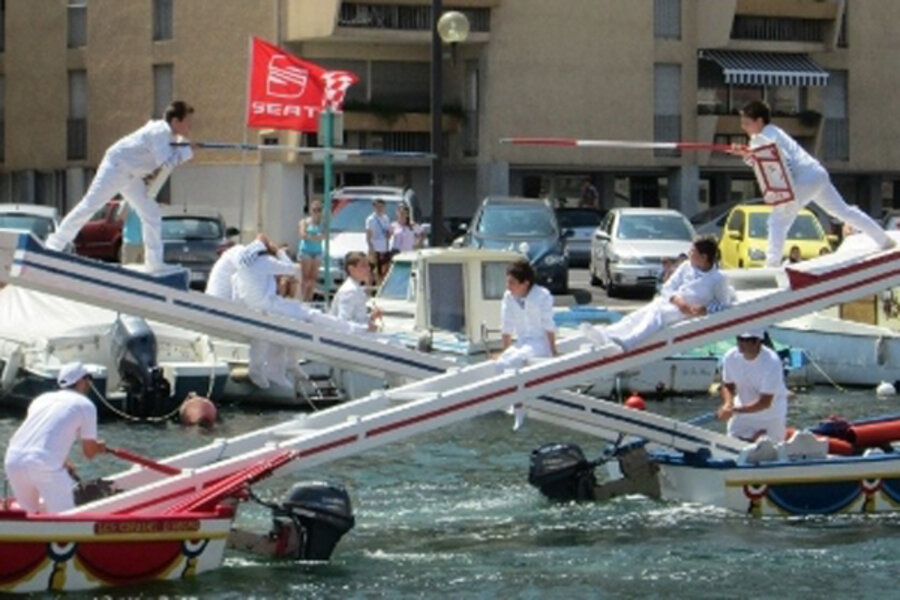Soccer? Mais, non! French children go wild for medieval water jousting
Loading...
| Sete, France
It’s the height of summer, when kids across the US head off to overnight soccer camps or swim team practice.
Meanwhile their counterparts in Sete, a fishing town sliced with canals on the French Mediterranean, are practicing a different hobby altogether: medieval water jousting.
This isn’t mock dueling – children dressed up as knights with visions of Lancelot. This is the famed “joute nautique” of the Languedoc region of southern France.
On a recent day, children from the local water jousting school are dressed in all white, standing on platforms perched high off of the ends of boats resembling gondolas, as a tournament gets underway. Two competitors lunge forward, and when their boats cross – one blue, the other red – each attempts with a lance and shield to dislodge the other into the water.
When one falls, cheers erupt from the side of the banks of the Royal Canal.
While ancient traditions die out every day, locals here swear that jousting is alive and well, a crucial part of the community’s identity that has run through the generations – and centuries. “It’s about the ambiance, the friendship that forms among the town,” says Christian Fabre, whose grandson is participating in the tournament and who keeps careful tabs of who has gotten knocked down with the precision of someone tracking professional baseball statistics.
The “joutes” are “engrained in the minds of those from Sete,” says Mr. Fabre, who jousted from age 14 to 55. Hailing from a family of jousters that spans six generations, his 12-year-old grandson, Valentin, began when he was literally still in diapers – at age 2-1/2.
While the more popular tradition of jousting, on horses, appeared in the Middle Ages, historians have documented the version on water as far back as Egyptian times, spreading to Ancient Greece and the Roman empire. In France, its origins are traced to the 13th century, with records showing crusaders, about to embark to the Holy Land, engaged in game.
Water jousting is practiced in various parts of France and Europe but it is here in Sete, a pretty town of 43,000 called the “Venice of Languedoc,” where the sport is celebrated most fiercely. The first jousting tournament was documented when the town was founded in 1666, and 350 years later, the sport’s most famous celebration – a kind of World Series of jousting – happens at the end of each August: Sete’s five-day festival of “St. Louis.” Thousands line the Royal Canal to watch the adult men battle for the year’s title as best jouster.
But today it is children ages 10 to 15-year-olds that the town is watching, with bleachers set up along the canal’s banks and tents covering additional seats and a makeshift snack-bar, drawing at least 100 spectators.
The summer “school” has attracted 87 kids this year (all boys except for one girl), from ages 3 to teens. Before they know how to swim, the youngest children learn the art of the game on wagons. These boys, like French boys everywhere, are diehard soccer players, but when summer swings into force, they forget it for jousting, says Remi Pecheral, who works at the school.
It’s a difficult sport, requiring strength, precision, balance, and strategy that must adapt to the winds and currents. A jouster must strike a specific quadrant of a shield, called the pavoir. The slightest mistake and a jouster plunges into the water. Judges on microphones carefully view each move, to make sure no rules have been broken.
The school aims to instill the love for tradition in Sete's children, but many locals swear that it would be passed down anyway among the Setois, as the residents here are called.
Kelian Caramel, age 11, learned about jousting from his grandfather, who took him to the tournaments when his father was at work. He began jousting at age 5. (“He was old,” says his father Christophe Caramel, deadpan.)
For Mr. Caramel, the allure of jousting spans far beyond the competition – it is about the parades that filter through the streets ahead of each tournament, the costumes and straw hats, the somber music of oboe and drum that accompanies the competitions. “The folklore,” he says.
Sometimes the tradition is passed “up.” Anne de Maistre moved to Sete at age 12, with little exposure to jousting. But when her son Alban was an infant, she’d walk through the streets, her crying son in her arms, and he’d fall silent each time they’d pass a jousting contest, parade, or practice.
As soon as he started talking, she says, he pleaded with his mother to joust. “I didn’t want him to,” she says. “There was a lance, I was afraid of him partaking in combat,” she says.
But the Setois talked her into it, and he was enrolled at age 5. It’s a decision she doesn’t regret. “It’s very important for children to learn to fight against their opposition, it’s something they can use for the rest of their lives,” she says.
For Alban, now aged 10, it’s simply fun – what a boy does during the summer in Sete. Tanned and soaking wet, he won his first duel in today's tournament but then lost his balance facing the school’s top jouster.
Now Alban's father has followed in his footsteps. "My son was the first in the family to joust," says Xavier de Maistre, who began jousting four years ago and says it's crucial the tradition continues. “It’s not just a sport, it’s also about the celebration."
The jousting community likes to point out that no money is involved. “It is only about prestige,” says Mr. Pecheral, one that honors and celebrates the community’s roots.






